
Selecting the right food, beverage or pharmaceutical hose is a critical decision for businesses operating in hygienic industries. The right food and beverage hose choice will safely convey liquids, ingredients and maintain hygiene during cleaning processes. However, with a myriad of food and beverage hose options available, the selection process can be challenging. Factors such as chemical resistance, temperature and pressure, hose construction, hose attachment methods, hose end fittings, and hose flexibility and bend radius must be carefully considered. In this article, we will look at the key factors that can help you make an informed decision when considering food and beverage hoses for your specific application.
Utilize STAMPED
When choosing a food, beverage, pharmaceutical hose, or any industrial hose for that matter, STAMPED should be utilized to concisely and efficiently gather application information. The STAMPED acronym is an industry-wide standard and stands for Size, Temperature, Application, Material, Pressure, Ends and Delivery. Check out our article STAMPED – Choosing the Right Hose For Your Application for more information on the STAMPED process. Besides STAMPED it’s important to know accompanying factors that are directly related to food & beverage processes, such as if the hose needs to be resistant to fats/oils and if you have a certain cleaning in place process (CIP process) in place that the hose will need to be chemically compatible with. Other construction features and aesthetic features, such as the weight of the hose and abrasion resistance, may also be important depending on application and operator preference.
Chemical Resistance
It goes without saying that making sure food, beverage, and pharmaceutical hoses are made out of non-toxic and non-metal materials is paramount to maintaining sanitary and safety standards. Food and beverage hoses come into contact with cleaning agents, sanitizers and different types of food and beverage products, so choosing the right kind of chemical-resistant hose material is necessary to prevent contamination. Metal hoses for instance are an example of the wrong material for food & beverage hoses because they are prone to corrosion. Corrosion will contaminate the product. Hoses with strange odors can also cause contamination by transferring unwanted smells and tastes to products. Choosing a food and beverage hose with an odorless tube is the best course of action. If harsh cleaning agents are used in a cleaning process, it’s advisable to use a hose with a UHMWPE or PTFE inner tube to increase chemical compatibility and maintain hygiene standards. It’s important to be safe when choosing the hose material not only because there is a safety responsibility, but to comply with regulations. Compliance regulations, set by the Food and Drug Administration (FDA), have been put into place to maintain high safety and quality standards with consequences including fines and potentially being shut down.
Hose Construction
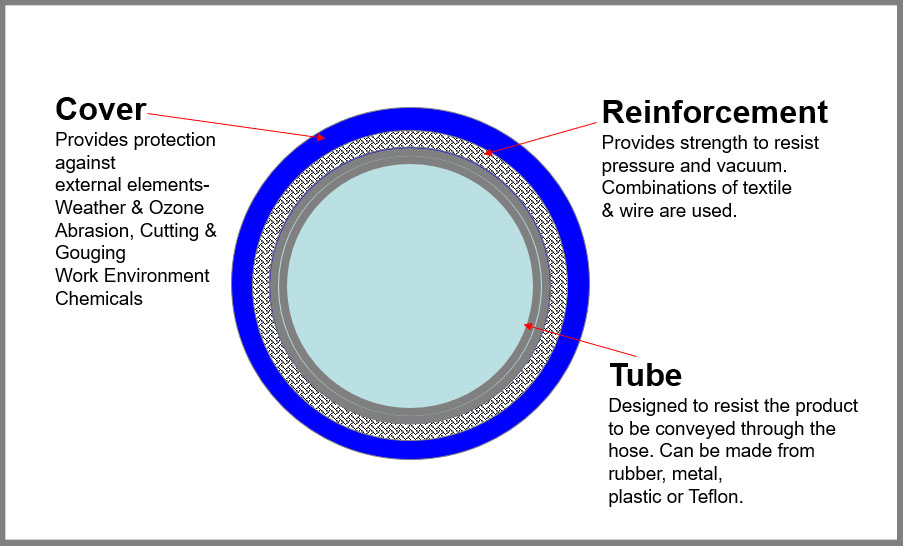
There are numerous materials food, beverage, and pharmaceutical hoses can be made from. PVC, PTFE, EPDM, NBR, Silicone, and thermoplastic elastomers (TPE) are generally the most utilized material options. Understanding the hose material and how it will react with the application it’s used for is critical to selecting an appropriate hose. For example, PVC hoses that are used for food and beverage are often transparent, lightweight, and generally pretty flexible, but the downside is they are not suited for oily substances, high temperatures and pressures. Following those attributes, PVC is good to use for an application such as drinking water and soft drinks where operating temperatures and pressures are minimal. PVC however, can’t handle transporting oily substances such as grease or mayonnaise because it will harden and crack over time. Environmental conditions are also a factor that needs to be considered. Extreme temperatures, abrasion potential, sunlight, etc. will wear hoses down. Heavy-duty hose construction materials and abrasion-resistant hose covers may need to be prioritized under such conditions in order for the hose to have lasting power.
Photo Credit: The Novaflex Group
Core Tube Construction
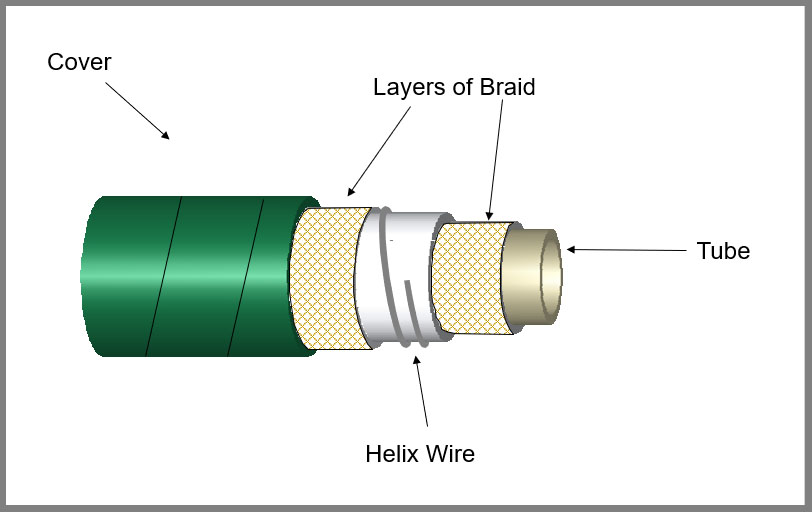
When selecting a hose, the core tube is a great place to start. The core tube is the innermost layer of the hose and has the most exposure to the system media. It’s extremely important that the core tube be chemically compatible with the system media. If the hose is not compatible with the system media it can corrode, deteriorate, and potentially fail. Will the hose’s core tube limit permeation or absorption? Permeation occurs when the media passes through the core material, while absorption occurs when the media absorbs into the core material. Depending on the media involved this could potentially be an issue or not be of any consequence. Another important factor to keep in mind is whether the core material will be compatible with the system cleaning procedure. The core tube will need to be able to withstand factors such as temperature, pressure and be compatible with any solvents and cleaning agents used. There are a couple of core tube options that standout when it comes to food & beverage applications, smooth-bore and convoluted. A smooth-bore tube, as the name alludes to, has an inner wall that is smooth. Hoses with smooth-bore cores are used when precise flow control is a priority. Since there are no grooves or irregularities in the hose wall, smooth bore cores can transfer media without delay or interruption. The smooth wall also excels at being able to drain easily. The biggest issue with smooth bore core hoses is their prone to kinking, especially in large diameters. Hose reinforcement helps with this issue, but flexibility can suffer as a result. When precise flow control isn’t a top priority, convoluted hose cores are good options to prevent kinking. Convoluted hose cores are folded in a pattern that increases bending without kinking. The best flexible material options for convoluted cores where increased flexibility is needed for a food and beverage application are fluoropolymer and silicone. Fluoropolymer hoses are continuing to grow in popularity among sanitary applications thanks to their strong chemical compatibility and high-temperature ratings. Silicone hoses are a popular choice for sanitary applications because they have great flexibility and can withstand temperatures usually up to 500 degrees.
Photo Credit: The Novaflex Group
Hose Reinforcement
Hose reinforcement is important for the flexibility and robustness of food, beverage, and pharmaceutical hoses. Generally, the core tube is reinforced with a flexible, stainless-steel wire or spiral reinforcement. The wire or spiral reinforcement improves pressure control and flexibility, which is crucial when a hose is connected to a working system. A wire helix or spiral reinforcement contributes to the hose’s crush resistance. Food and beverage hoses may be subjected to crushing forces when being run over by equipment or when used in applications with heavy loads. Reinforcement materials provide structural integrity and shield the hose from collapsing or being damaged due to external pressure or impact. In certain food & beverage applications vacuum is utilized and the proper hose reinforcement will be needed to resist the vacuum and negative pressure conditions. In this case, the hose reinforcement is integral to maintaining the hose’s shape and preventing it from collapsing when subjected to suction forces. Reinforcement materials with high tensile strength such as wire helix are commonly used to enhance vacuum resistance.
Special Cover
Does your food, beverage, or pharmaceutical hose need a special cover? Depending on the environment, hoses are commonly dragged, bent beyond their bend radius, collect bacteria in cover grooves, and other potential issues. An abrasion-resistant cover might be a good option if the hose will likely be dragged or have other physical harm done. Bend restrictors, a type of cover, might be a good option for food & beverage hoses if there’s a chance the hose could overbend when put into service. A silicone hose cover is easy to clean and a great option to prevent bacteria growth. These cover options are something to think about when choosing a food and beverage hose that’s best for the application.
Hose Attachment Methods
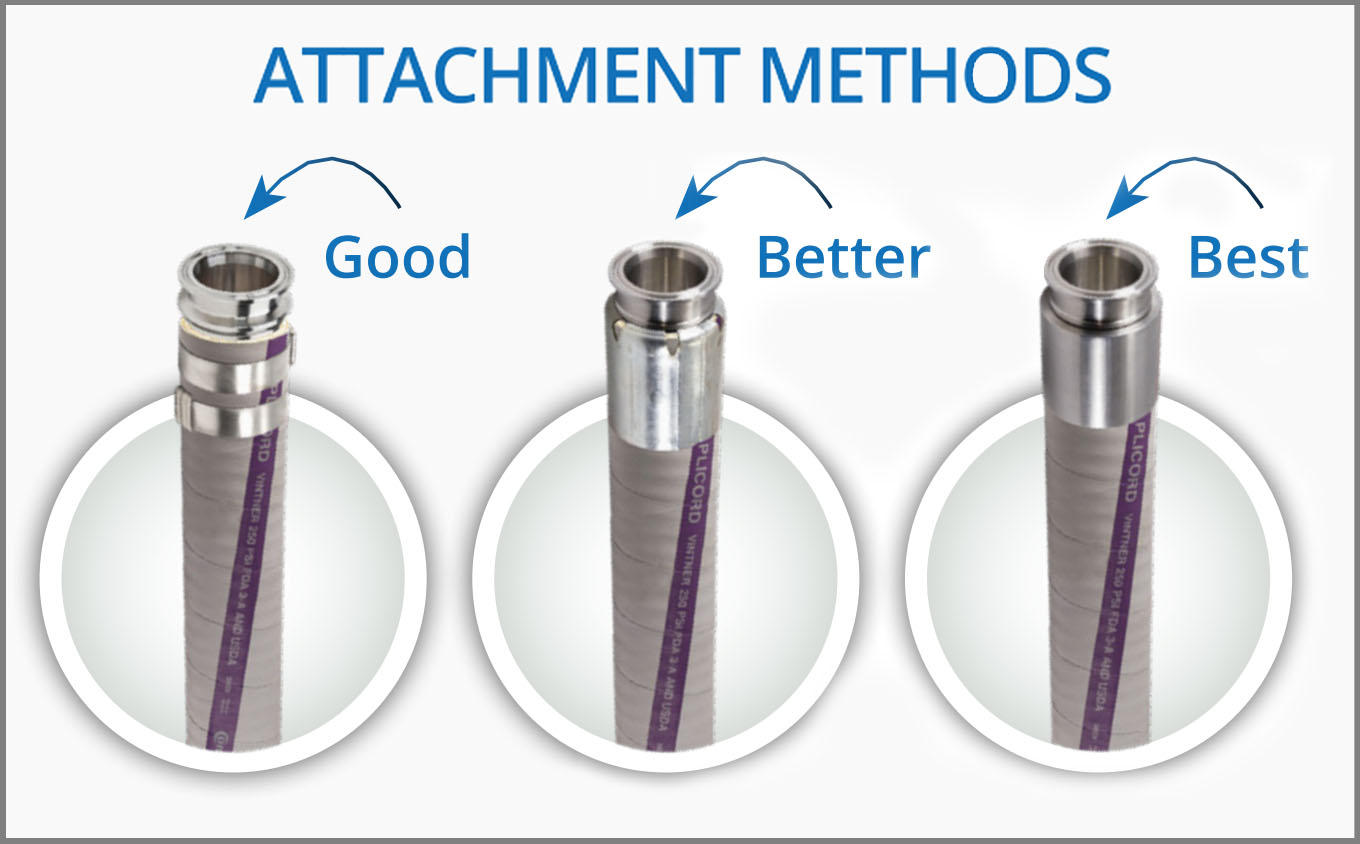
Food, beverage, or pharmaceutical hoses can be attached to equipment or services using various methods depending on the specific requirements of the application. Hose clamps are a widely used, economical way to secure hoses to fittings or equipment. They consist of band that’s usually made of metal, and a screw or bolt that tightens the band around the hose, creating a secure connection. Clamps are not recommended as a permanent sanitary attachment due to the fact they leave hose ends exposed, leaving an easy entry point for bacteria. The best use of clamps is using them as a temporary fix for applications with higher pressures. A more secure and sanitary option is crimping the hose. Crimping is the compressing of a ferrule or sleeve around the barbs of a hose fitting, thus creating a leak-free seal. A crimped hose significantly reduces the risk of bacteria or sediment gathering on the inside of the hose and the fitting. Crimping a hose also provides excellent flow rates. Normal crimped ferrules, with notches kind of resembling a claw, are far superior to clamp fittings sanitary-wise, but since there are still gaps in the ferrule, those areas can still be places where debris or bacteria can accumulate. Sanitary ferrules crimped onto the hose are the best choice for food & beverage applications. Since a sanitary ferrule has no gaps and is completely sealed, there are no places for bacteria to accumulate making them perfect for food & beverage and hygienic applications.
Hose End Fittings
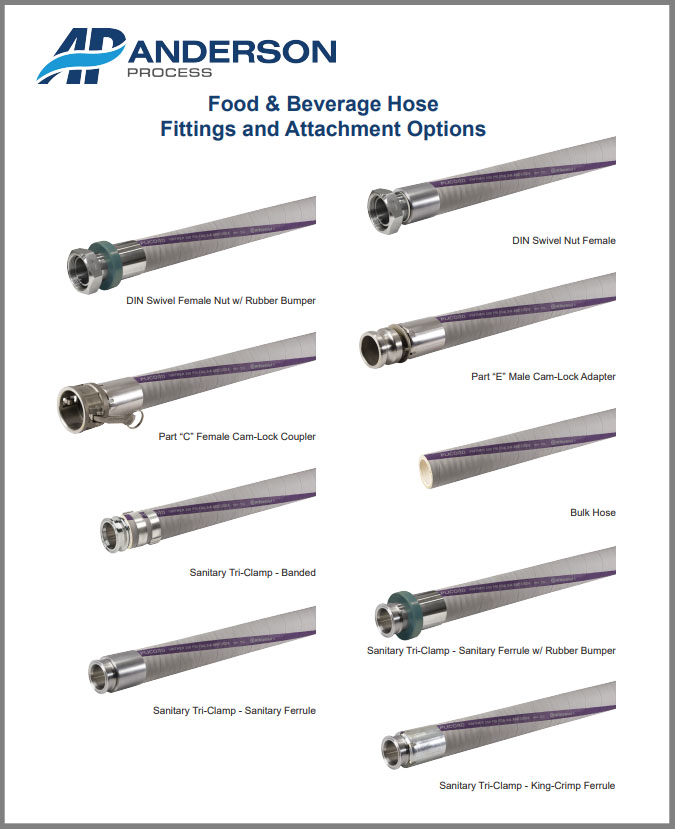
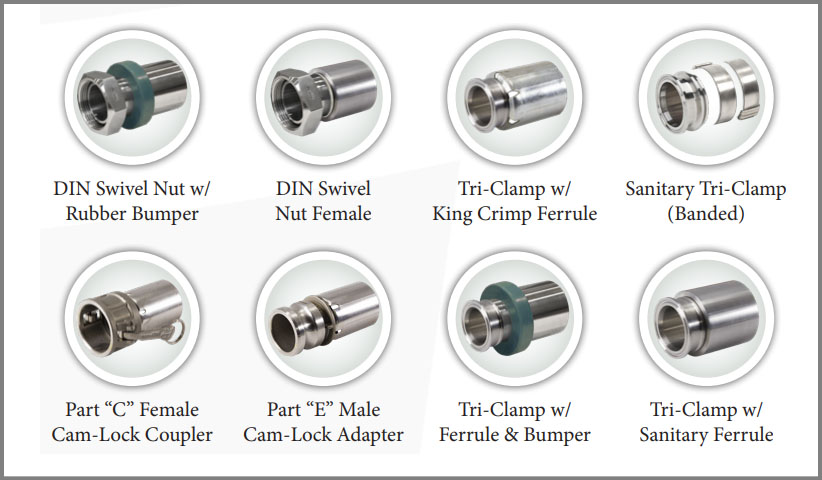
Food, beverage, or pharmaceutical hoses have several end-fitting options. Some common end fittings on food and beverage hoses include tri-clamp fittings, camlock fittings, threaded fittings, flanged fittings and quick disconnect fittings. Tri-Clamp fittings are widely used fittings in the food and beverage industry. They consist of two ferrules and a gasket that are clamped or crimped together to form a secure, hygienic connection. Connecting to equipment like pumps, tanks and process vessels is simple with tri-clamp fittings. Camlock fittings, also referred to as cam & groove fittings are quick-connect fittings and are no stranger to the food & beverage industry. Cam & groove couplers (consisting of a male and female) click into place and can easily be engaged or disengaged using the camlock arms. They are available in several materials, including stainless steel and polypropylene. Cam & groove fittings are a fast, convenient fitting to use for applications that require frequent hose connections and disconnections. Threaded fittings Like NPT (National Pipe Thread) and BSP (British Standard Pipe) are commonly associated with food and beverage hoses. These fittings use threaded connections to join hoses with equipment or systems. Stainless steel and brass are common materials for threaded fittings and are reliable options for food & beverage applications. Used for high-pressure or high-temperature conditions, flanged fittings are a reliable choice for heavy-duty food & beverage applications. Flanged fittings consist of a flange and a gasket and connect hoses to equipment or pipes. Known for providing strong and leak-resistant connections, flanged fittings are perfect for hygienic applications.
Flexibility and Bend Radius
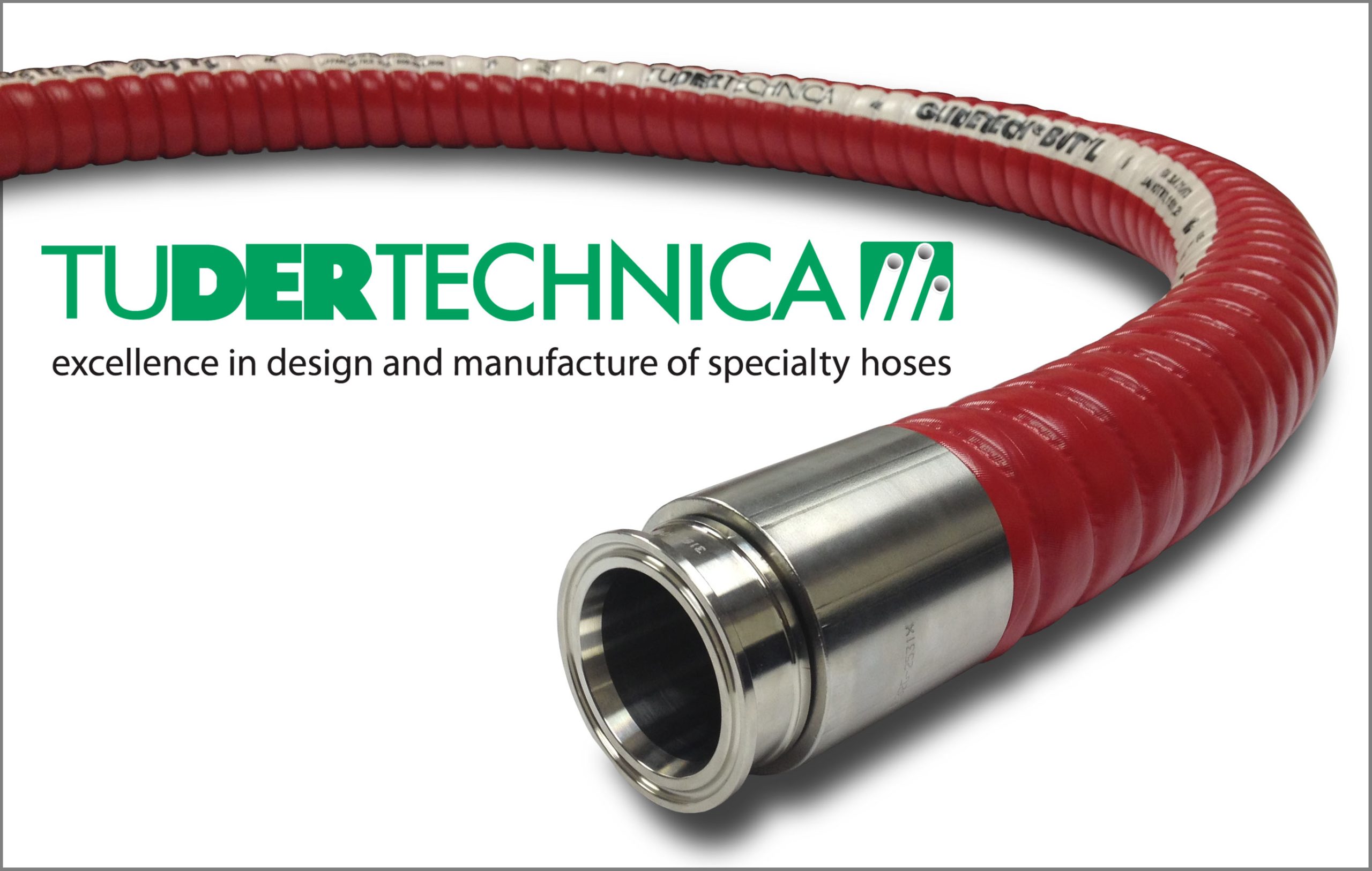
How much flexibility from the hose will the application need? There are several factors to consider such as space constraints, maneuverability requirements, and the hose’s ability to handle tight bends without kinking or collapsing. The Durometer (hose hardness measurement), construction attributes like wall thickness, reinforcement materials, and force needed to bend the hose should be evaluated before an appropriate hose option is chosen. Generally, hoses that have a low bend radius have more flexibility, are easier to maneuver, and are safer to use than more rigid hose options. Typically more heavy-duty rigid food & beverage hose options don’t offer much flexibility, but often have a stainless steel or thermoplastic helix to prevent the hose from being crushed or kinked. Operators often have to make a choice between having a more heavy-duty, rigid hose with less flexibility versus a more flexible hose with less protection and potentially a better chance of kinking. Assessing the needs of the application will help determine the best choice.
Selecting the best food, beverage, or pharmaceutical hose for your application is a critical task that should not be taken lightly, especially with the health and well-being of consumers on the line. By considering factors such as the STAMPED information, hose construction, hose attachment methods, chemical compatibility, flexibility and bend radius, you can ensure safety of your operations. It is essential to choose a hose that is compatible with the food or beverage it will come in contact with, preventing contamination and maintaining product integrity. Additionally, complying with industry regulations and standards demonstrates commitment to quality and consumer safety. By conducting thorough research, consulting experienced professionals and making an informed decision, you can find the best food and beverage hose to meet your specific needs, while ensuring regulatory compliance and contributing to the success of your business.
Anderson Process is a top-tier distributor for several food, beverage, pharmaceutical hose and fitting manufacturers, including Continental, Novaflex, Tudertechnica, Dixon Valve, Campbell Fittings and Rubberfab.
